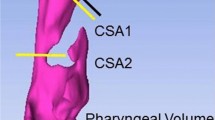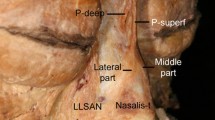Abstract
Objective
The objective of this study was to verify a possible correlation between the etiology of uvulopalatal ptosis and decrease in palatopharyngeal muscle tone, due to a reduction of the number of nerve fibers in surgical specimens obtained from snoring patients.
Design/setting of the study
We have designed a comparative retrospective, case–control, double-blind, immunohistochemical and histomorphometric study of human uvula innervation in 51 apneic snoring patients who underwent uvulopalatopharyngoplasty (UPPP) and 47 normal subjects collected in a 5-year-long period in the Departments of Otolaryngology of Desio and Forlì Hospital, Italy.
Patients
Case study was chosen in patients who underwent UPPP, variably associated with other disobstructive surgical procedures for treatment of obstructive sleep apnea syndrome, classified according to current clinical, polysomnographic, endoscopic, and imaging criteria. Control subjects were recruited at the Institute of Legal Medicine, University of Milan, according to strong inclusion and exclusion criteria. The main outcome measure of the study was the number of nerve fibers in the patients' uvula evaluated histologically and repeated two times by two different people, in all the areas of the specimens. Finally, we correlated the area of the histological section with the number of fibers contained therein.
Results
The number of nerve fibers varied from a minimum of 58 to a maximum of 163 in normal subjects. In the snoring patient population, the number of nerve fibers varied from a minimum of 22 to a maximum of 126 (statistically significant difference, p < 0.0001). In conclusion, our results direct toward a clear neurogenetic predisposition to uvulopalatal ptosis, marked ab initio by a lower set of motor nerve fibers, which may be the initial stage of another subsequent morphological and functional abnormality.

Similar content being viewed by others
References
Namysłowski G, Scierski W, Zembala-Nozyńska E, Nozyński J, Misiołek M (2005) Histopathologic changes of the soft palate in snoring and obstructive sleep apnea syndrome patients. Otolaryngol Pol 59(1):13–19
McNicholas WT, Coffey M, McDonnell T, O'Regan R, Fitzgerald MX (1987) Upper airway obstruction during sleep in normal subjects after selective topical oropharyngeal anesthesia. Am Rev Respir Dis 135(6):1316–1319
Loubaki L, Jacques E, Semlali A, Biardel S, Chakir J, Sériès F (2008) Tumor necrosis factor-alpha expression in uvular tissues differs between snorers and apneic patients. Chest 134(5):911–982
Bassiouny A, Mashaly M, Nasr S, Atef A, Ayad E, Qotb M (2008) Quantitative analysis of uvular muscles in cases of simple snoring and obstructive sleep apnea: an image analysis study. Eur Arch Otorhinolaryngol 265(5):581–586
Boyd JH, Petrof BJ, Hamid Q, Fraser R, Kimoff RJ (2004) Upper airway muscle inflammation and denervation changes in obstructive sleep apnea. Am J Respir Crit Care Med 170(5):541–546
Guilleminault C, Huang YS, Kirisoglu C, Chan A (2005) Is obstructive sleep apnea syndrome a neurological disorder? A continuous positive airway pressure follow-up study. Ann Neurol 58(6):880–887
Edström L, Larsson H, Larsson L (1992) Neurogenic effects on the palatopharyngeal muscle in patients with obstructive sleep apnoea: a muscle biopsy study. J Neurol Neurosurg Psychiatry 55(10):916–920
Guilleminault C, Ramar K (2009) Neurologic aspects of sleep apnea: is obstructive sleep apnea a neurologic disorder? Semin Neurol 29(4):368–371
Woodson B, Garancis J, Toohill R (1991) Histopathologic changes in snoring and obstructive sleep apnea syndrome. Laryngoscope 101:1318–1322
Riley RW, Powell NB, Guilleminault C (1993) Obstructive sleep apnea syndrome: a surgical protocol for dynamic upper airway reconstruction. J Oral Maxillofac Surg 51(7):742–749
Stål PS, Lindman R, Johansson B (2009) Capillary supply of the soft palate muscles is reduced in long-term habitual snorers. Respiration 77(3):303–310
Urschitz MS, Guenther A, Eitner S, Urschitz-Duprat PM, Schlaud M, Ipsiroglu OS, Poets CF (2004) Risk factors and natural history of habitual snoring. Chest 126(3):790–800
Friberg D, Gazelius B, Lindblad LE, Nordlander B (1998) Habitual snorers and sleep apnoics have abnormal vascular reactions of the soft palatal mucosa on afferent nerve stimulation. Laryngoscope 108(3):431–436
Kuehn DP, Folkins JW, Linville RN (1988) An electromyographic study of the musculus uvulae. Cleft Palate J 25(4):348–355
Friberg D (1999) Heavy snorer's disease: a progressive local neuropathy. Acta Otolaryngol 119(8):925–933
Friberg D, Ansved T, Borg K, Carlsson-Nordlander B, Larsson H, Svanborg E (1998) Histological indications of a progressive snorers disease in an upper airway muscle. Am J Respir Crit Care Med 157(2):586–593
Bassiouny A, Nasr S, Mashaly M, Ayad E, Qotb M, Atef A (2009) Electron microscopy study of peripheral nerves in the uvulae of snorers and obstructive sleep apnoea patients. J Laryngol Otol 123(2):203–207
Conflicts of interest
Not one of the authors have conflicts of interest in this paper.
Author information
Authors and Affiliations
Corresponding author
Additional information
Dr. De Bellis and Dr. Pagni contributed equally to the ideation and management of this paper.
Rights and permissions
About this article
Cite this article
De Bellis, M., Pagni, F., Ronchi, S. et al. Immunohistochemical and histomorphometric study of human uvula innervation: a comparative analysis of non-snorers versus apneic snorers. Sleep Breath 16, 1033–1040 (2012). https://doi.org/10.1007/s11325-011-0597-7
Received:
Revised:
Accepted:
Published:
Issue Date:
DOI: https://doi.org/10.1007/s11325-011-0597-7




